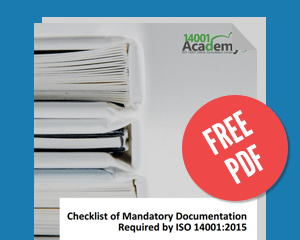In ISO 14001 there are very few pieces of information in the environmental management system that need to be documented, and none of these are required documented procedures. There are a couple of documents like policies, plans, and records that need to be written, but no written procedures are explicitly mandated by the standard. So, how do you decide which of the procedures in the ISO 14001 standard should be documented in your environmental management system?
What does ISO 14001 say about documenting procedures?
In requirement 4.4.4 e) the ISO 14001 standard specifies the need for “documents, including records, determined by the organization to be necessary to ensure the effective planning, operation and control of processes that relate to its significant environmental aspects.” What does this mean?
The intent of this requirement is for the organization to assess which of their interactions with the environment have a significant impact, and to have a documented method of controlling this interaction. This way, all employees who are involved in that process can have a common understanding of what is needed to ensure that a significant negative impact on the environment is avoided. It is important to note that this is only applicable for significant aspects; if you do not have a process with a significant impact, then it is not required to have a procedure for all operational controls.
For instance, if you have a process that emits wastewater to the sewer, you might need a “Guideline for wastewater & sewage management”; if you have electronic waste that needs to be properly disposed of, you might need a “Guideline for electronic waste management.” If you do not have hazardous waste, or it is not a significant aspect, then you don’t need a “Guideline for hazardous substance management.” Each company must decide on their own what is a significant environmental aspect and write an appropriate procedure accordingly.
What are some guidelines on documenting procedures for the EMS?
A very good rule of thumb is to document a procedure when there is a high chance that there will be mistakes when it is not documented. This is particularly applicable to procedures used for planning the response during an emergency. These procedures can be critical to ensuring that everyone knows who can respond, what training is required and maintained for the responders, and what other people should do when the emergency occurs, even if this is to just be out of the way of the emergency responders.
Another time to consider documenting a procedure is when you want to ensure that the review criteria and the assessed output are consistent across the organization. For example, you don’t need to have a procedure on how you identify and classify your environmental aspects (the ways that your organization’s processes interact with the environment), but if you want to make sure that all process owners look at the same items to assess what an aspect is (and more importantly, that all personnel assess what is significant in the same way), then writing down a procedure that identifies these specific requirements is important.
Some processes of an EMS that are very commonly documented include:
- How you identify and classify your environmental aspects
- How you identify and keep applicable legal requirements up to date
- How you determine competence, awareness, and training
- How the documents and records of the EMS are controlled
- Emergency plans and how they will be executed should an identified emergency occur
- How nonconformity, corrective action, and preventive action are carried out
- How an internal audit is conducted
- How a management review is performed
EMS documentation doesn’t need to be long and cumbersome
By documenting only the procedures that you will need for your EMS to properly function and improve, you can avoid the trap of having a lot of wordy documents that are difficult to read and maintain. If your procedures contain the information that is needed, without a lot of extra information that is not used, you will also increase the chances that your documentation will remain relevant and be used by the employees who need to know what is written. In this way you can keep your EMS implementation lean, useful, and relevant.
For some more information on what documentation is mandatory in the environmental management system, see this free whitepaper: Checklist of Mandatory Documentation Required by ISO 14001:2015.

 Mark Hammar
Mark Hammar 




